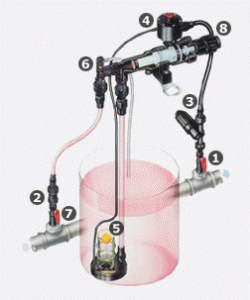Solution for farmers, Household
Fertigation - the key to higher yields, healthier Crops
(Dairy Vietnam) In the late 1970's, a new concept materialized To serve the international farming community: fertigation. A natural step forward in agricultural technique, fertigation (from the words fertilizer and irrigation) is an effective method of applying chemicals and fertilizers To crops via the existing irrigation system.
The need For fertigation derives from the fact that traditional methods of fertilization are only partially effective and leave a lot To be desired. At the time the fertilizer is distributed, it may be too strong For the delicate roots of the young saplings, causing Then irreparable damage. Or on the other hand, it may be too weak, and thus useless. Most important however, is the fact that spread or sprayed fertilizer remains near the surface, hardly reaching the root tips and root hairs - the points of greatest absorption.
In the process of fertigation, fertilizer is applied directly with the irrigation water. Therefore, wherever the water goes, the fertilizer goes with it. Fertilizer is applied only where needed, and in the proper quantities. |
|
The obvious advantages of fertigation, therefore, are the saving of labor and machinery, and the efficient use of the costly chemicals and
fertilizers To be applied. In fertigation, the extra activities involved in the separate application of fertilizer are no longer necessary; neither
is the purchase of maintenance of dedicated equipment For fertilizer distribution. Additionally, such machinery often compresses the soil and
may cause crop damage. In conclusion, one might say that fertigation is the most effective and least expensive way of proving nutrients To
growing field crops. |
|
|
 |
| |
|
 |
 |
Water driven chemical injectors that need no external power supply. |
 |
Does not cause pressure loss in the irrigation line. |
 |
Operation begins at low pressure. |
 |
Simple operation, adjustments and maintenance. |
 |
Chemical resistant To nearly all known chemicals used in agriculture and horticulture. |
|
|
Fertilizer injector units 4-01 and 4-02
The Amiad Fertilizer and Chemical Injector units 4-01 and 4-02 require no external power supply. Their linear hydraulic motor is powered by the hydraulic pressure of the irrigation system. The units are supplied with all the necessary pipes, fittings and accessories For immediate operation. Control: The maximum injection rate of the pump is proportional To the pressure in the main line, thus the required injection rate is easily adjusted by throttling the injection line. Each pulse injects 1/30 liters of chemicals - the liters of fertilizer injected per hour = twice the number of pulses per minute. |
 |
| 1. Drive water hand valve |
| 2. Raccord connector |
| 3. Drive water filter |
| 4. Automatic cut-out |
| 5. Suction head |
| 6. Air release valve |
| 7. Injection line hand valve |
| 8. Water exhaust |
|
|
|
| Injection rate |
Up To 320 liters/hr; 1.4 USgpm
according To mains pressure. |
 |
| Minimum pressure |
0.5 bar; 7 psi |
| Maximum pressure |
8 bar; 115 psi |
| Water consumption |
3 times the quantity of the chemical
injected. The installation of flow
regulators will increase water
consumption. |
| Gross weight |
5 kg (11lb) packaged |
| Construction materials |
Chemical-resistant engineering plastics;
stainless steel; Viton seals For parts in²
contact with chemicals. |
|
 |
| |
The Amiad TMB fertilizer pumps evenly distribute the fertilizers throughout your irrigation system - over the whole area of the field. The pumps inject the fertilizer solution in To the irrigation system where it is mixed with the flowing water. When sprayed through the sprinklers or drippers, the fertilizer will uniformly reach the roots of all plants being irrigated. The Amiad TMB fertilizer pumps are driven solely by the water picked up from the irrigation line itself and can be operated anywhere in the field as long as water pressure exceeds the minimum requirements per unit (see specifications below): |
|
|
| Injection rate* |
8-50 l/h; 3-13 USgph |
15-250 l/h; 4-66 USgph |
50-600 l/h; 13-158 USgph |
| Minimum pressure |
2 bar; 30 psi |
2 bar; 30 psi |
2 bar; 30 psi |
| Maximum pressure |
8 bar; 120 psi |
8 bar; 120 psi |
7 bar; 100 psi |
| Connections |
1/2" |
3/4" & 1/2" |
3/4" |
| Weight |
3.5 kg; 7.7 lb |
12 kg; 26.5 lb |
24 kg; 53 lb |
| |
 |
 |
 |
| Water consumption |
2 times the quantity of the chemical injected |
| Construction materials |
Body: Stainless steel 316
Springs: Stainless steel 302
Shafts: Stainless steel 316, Brass
Diaphragms: NBR & Natural rubber
O-Rings: NBR & Viton
Plastic parts: PP, PA, PVC & Teflon |
|
| *Injection rate is related To the operating pressure of the pump. |
Source: amiad.com
User Comments
Other article

